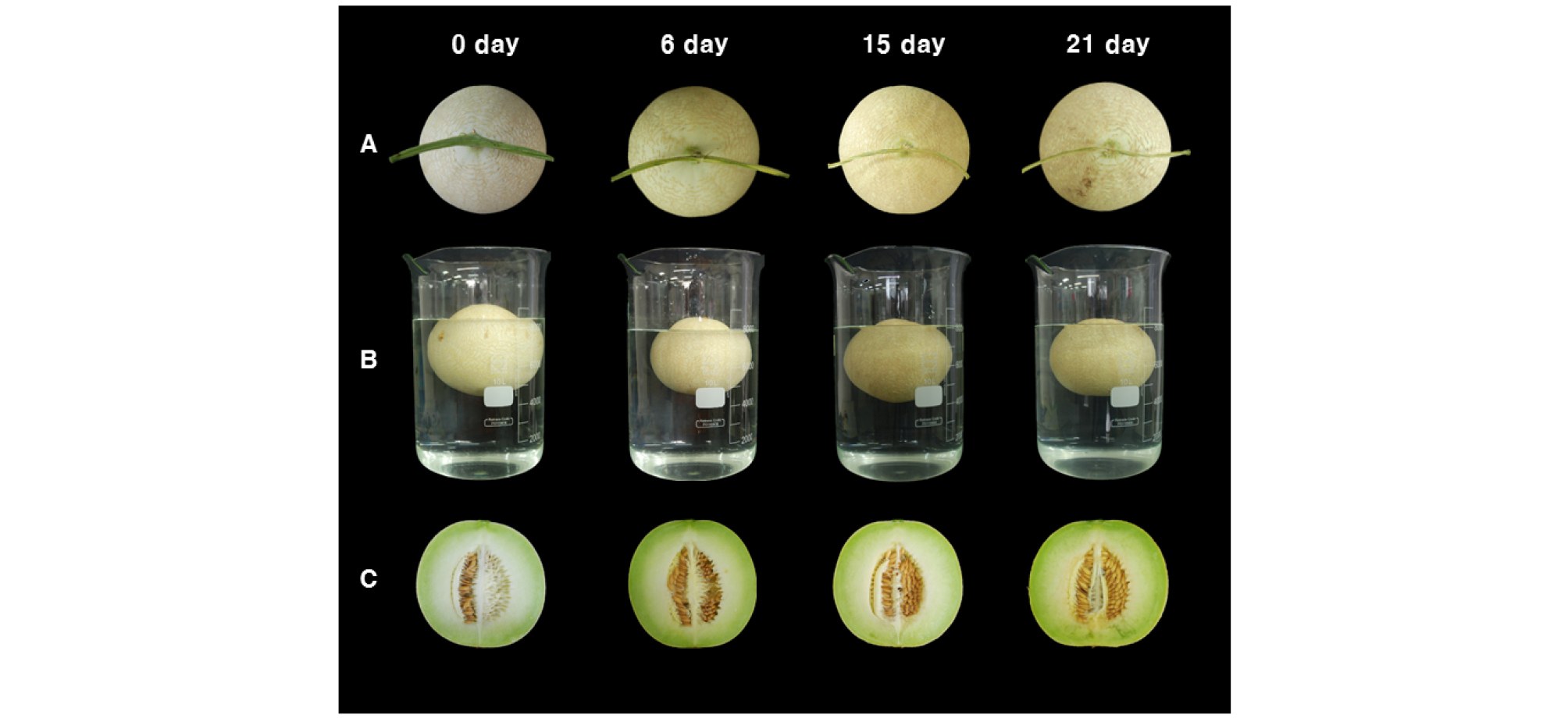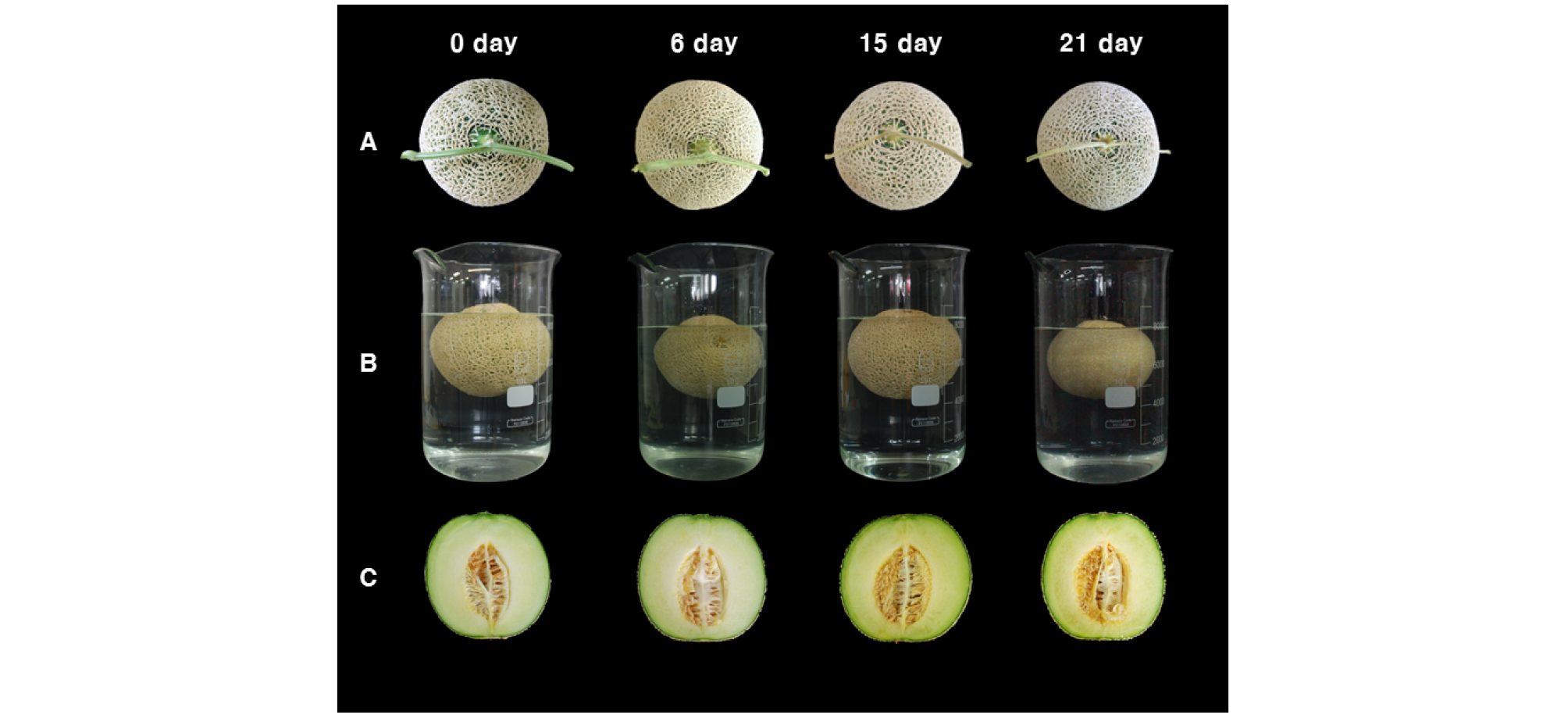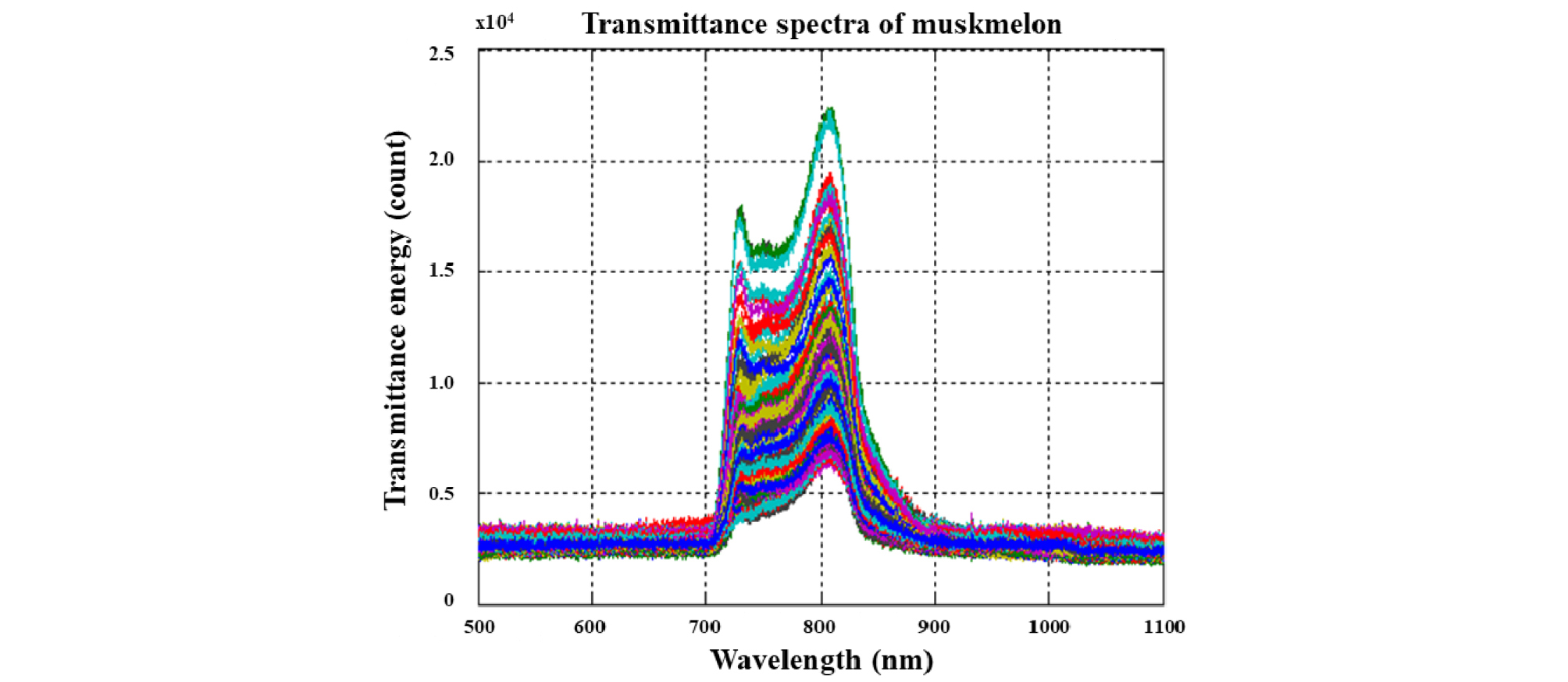Introduction
Materials and Methods
Plant material
Measurement of changes in moisture of the stalk and specific gravity
Vis/NIR spectra measurement and analysis
Reference analysis: firmness, TSS and TA
Results and Discussion
Correlation between the moisture of stalk and the quality
Correlation between the specific gravity and the quality
Prediction of ripening of intact muskmelon by using Vis/NIR spectra
Introduction
Muskmelon (Cucumis melo L. var. reticulatus) is juicy and tasty fruit that belongs to Cucurbitaceae family and believed to have originated from East Africa. It has been distributed from the country of origin to Mediterranean region, Asia, Northern Europe and America (Youn et al., 2009). Muskmelon is cultivated in all tropical and subtropical areas of the world for its nutritional and medicinal value. Worldwide annual production of melons including muskmelon (cantaloupes) was 31.17 million Mt from 1.24 ha million; out of which Republic of Korea took a share of 161,692 Mt from 5,273 ha (FAOSTAT, 2016). In Korea, consumption has been raising with the increase of the cultivation area and with high-quality melon production since the 1990s (Park and Moon, 2004).
In Korea, melon crops are generally grown during winter-spring season in greenhouses where environmental conditions for the crops are precisely controlled with high energy input (Suh et al., 2012). Relevant techniques for prediction of ripening quality are needed at any point in the distribution system to fulfill consumer’s preferences.
Most of the methods currently used as a ripening indicators of muskmelon are destructive; destructive analysis allows accurate quantification of quality indices. However, destructive methods are laborious, require proper skill to produce consistent results, costly, time consuming, and require sample preparation and need precautions. Moreover, the destructive methods use very few number of fruit samples to analyze the characteristics of one batch and the measured averaged attributes could not represent the individual fruit (Tilahun et al., 2018). This eventually necessitate the development of rapid, low-cost and reliable non-destructive methods for prediction of ripening quality.
Walsh et al. (2004) reported that sorting of various intact fruit could be achieved by NIR spectroscopy. NIR Spectroscopy is a method that uses the near-infrared region of the electromagnetic spectrum (from about 780 nm to 2500 nm) and has become one of the important modern nondestructive determination methods (Sun et al., 2010). NIR range spectra produce qualitative and quantitative information derived from the interaction between NIR spectra and organic compounds that forming the substance (Pasquini, 2003). When radiation hits a sample, the incident radiation may be reflected, absorbed or transmitted based on the chemical constitution and physical parameters of the sample (Sun et al., 2010). Clément et al. (2008) reported accurate prediction of lycopene content from fresh tomato by using Vis/NIR spectra at 400-1000 nm range and the results were almost as accurate as the results obtained from 400-1500 nm range. Tilahun et al. (2018) also reported the accurate prediction of lycopene and β-carotene using Vis/NIR spectrometer in spectral region of 500-1100 nm. In addition, Tian et al. (2007) observed the effectiveness of using Vis/NIR spectra in the range 350-1000 nm for measurement of soluble solids content in watermelon.
TSS, firmness and TA are some of the major characteristics used for assessing muskmelon quality (Seo et al., 2018). This study aimed to correlate objective quality parameters with nondestructive quality indicators to predict ripening quality of muskmelon. Hence, this study was conducted with the objectives (1) to investigate the correlations between moisture of the fruit stalk and specific gravity of the fruit with TSS, firmness and TA for estimation of ripening quality in muskmelon fruit; (2) to examine the possibility of using Vis/NIR spectra in 500-1100 nm range to predict TSS and firmness in intact muskmelon fruit.
Materials and Methods
Plant material
“Honey One” (Sejong Bio Co., Ltd) (Fig. 1) and “Earl’s Talent” (Nongwoo Bio Co., Ltd) (Fig. 2) muskmelon cultivars were harvested from Kangwon National University’s farm greenhouse. The fruits were transported directly to the postharvest laboratory after harvesting and medium sized (about 1.5 kg) fruits were selected by the Agricultural Products Quality Management Administration Standard. The selected fruits were kept at room temperature (25°C and 50 ± 5% RH) for better ripening (Seo et al., 2018). Data were collected at 3 days interval during 21 days of ripening period. Both cultivars and ripening periods were represented equally during data collection. Five fruit from each cultivar were considered for each sampling days. Totally 80 fruit (40 from each cultivar) were used during ripening period for eight sampling days. The destructive reference analysis for firmness, TSS and TA were made after taking the readings of Vis/NIR spectroscopy and specific gravity.
Measurement of changes in moisture of the stalk and specific gravity
The T-shaped stem stalk attached to the muskmelon fruit (Fig. 1A and 2A) was cut and measured for initial weight, followed by drying at 75°C for 3 days; the loss in moisture of the stalk was then calculated for each day observations by subtracting each day observation of dry weight of the stem stalk from the initial weight. The specific gravity for each observation days were measured as follows by the method of Cho et al. (2010).
| $$Specific\;gravity\;of\;muskmelon=\frac{Density\;of\;muskmelon}{Density\;of\;water}$$ | (1) |
Pictures were also taken by digital camera (Nikon corp., DX SWM ED IF Aspherical ⌀67, Thailand) during each day observations to see the changes in floatation characteristics in water, fruit stalk status and overall ripening conditions (Fig. 1 and 2). Pearson’s correlation test was used to correlate the changes in moisture of the stalk and specific gravity with reference analysis (TSS, TA, and firmness) (Table 1).
Table 1. Pearson correlation coefficients of the stalk moisture content and specific gravity vs. firmness, TSS, and TA of “Honey One” and “Earl’s Talent” muskmelon cultivars
Vis/NIR spectra measurement and analysis
The transmittance spectra of muskmelon were acquired from intact fruit using Vis/NIR spectrometer (Life & Tech, CO, Ltd, Yongin, Korea) (Fig. 3) in spectral region of 500-1100 nm as described by Tilahun et al. (2018) with two (12 V/ 100 W) halogen lamp as a source of Vis/NIR light and fruit holder to keep the fruit right above the detector (Fig. 3), the integration time was set to 300 ms and the measurement was done 5 times (different fruit directions) for a single fruit to reduce noise from being included. A total of 3500 data were saved for each measurement at 0.2 nm spectrum resolution. The spectra readings from the first six consecutive sampling periods were used for calibration set and readings from the last two sampling periods were used for prediction set. Transformation of the original spectra data was made by Hanning window, Standard Normal Variate (SNV), Multiplicative Scattering Correction (MSC) and first derivatives to reduce systematic noise and to remove unwanted information. To select the optimal number of latent variables in PLS model, cross validation was performed based on lowest predicted residual error sum of squares (PRESS) value. To establish a linear relationship between spectral data and measured references, partial least square (PLS) regression analysis was performed with MATLAB R2012b (Version 8.0.0.783, The Math Works, Inc., Natick, MA, USA). The performance of the developed PLS model was evaluated in terms coefficient of determination for cross validation (R2) and correlation coefficient for prediction (r2). In this study, we used the method reported by Kim et al. (2011) and Shao et al. (2007) to evaluate the performance of the prediction model. A predictive model with fewer bias value, SEC (standard error of calibration) and SEP (standard error of prediction) is considered to be good prediction model.
Reference analysis: firmness, TSS and TA
Fruits were selected based on their uniformity and freedom from defects and cut into sample slices and the firmness was measured at 1 cm and 2 cm from the peel (Seo et al., 2018); five readings were taken from each fruit. Firmness was determined using a rheometer (Model compac-100, Japan). Pressure was applied in the vertical direction with a maximum force of 10 kg using a 3 mm diameter round stainless steel probe with a flat end. The results were expressed in newtons (N) and correlated with moisture of the stalk, specific gravity and Vis/NIR spectra readings.
TSS and TA were measured according to Tilahun et al. (2017). Atago DR-A1 digital refractometer (Atago Co. Ltd., Tokyo, Japan) was used to measure soluble solids content (SSC) from five sample fruits at 20°C, and expressed in %. Titration of the diluted muskmelon juice (1 mL juice: 19 mL distilled water) was done with 0.1 N NaOH up to pH 8.1 using a DL22 Food and Beverage Analyzer (Mettler Toledo Ltd., Zurich, Switzerland) to obtain TA and the result was expressed as mg ‧ 100 g-1.
For PLS model in VIS/NIR spectra readings, samples were divided in to calibration and prediction sets to compare the performance of regression models developed by using firmness and TSS. Ten fruit samples (five fruit from each cultivar) were used during each sampling days of the ripening period at 3 days interval up to 21st day. Totally 80 fruit samples (40 fruit from each cultivar) were used for eight sampling days. Five spectra readings were taken from each fruit during sampling days. Hence, during each sampling days, 50 spectra readings were taken (“Honey One”, “Earl’s Talent”; 25 each). The fruit samples (60 fruit; 300 spectra readings) from the first six consecutive sampling periods were used for calibration set and fruit samples from the last two sampling periods (20 fruit; 100 spectra readings) were used for prediction set. A total of 80 fruits and 400 readings were used for the experiment (Table 2).
Table 2. Samples used for the PLS model in the vis/NIR spectra to develop the prediction and calibration models for non-destructive quality estimation of “Honey One” and “Earl’s Talent” muskmelon cultivars
Results and Discussion
TSS, firmness and TA are the main parameters used for indication of ripening quality of muskmelon fruit (Seo et al., 2018). In this study, TSS, firmness and TA data were collected in destructive method and correlated with non-destructive ripening indicators (moisture of the fruit stalk, specific gravity of the fruit and Vis/NIR spectra readings from the fruit) during ripening of muskmelon at 25°C up to 21 days. The results are presented and discussed as below.
Correlation between the moisture of stalk and the quality
Muskmelon producers and distributers are interested in measurements of quality attributes as they affect consumer acceptability. Reliable nondestructive techniques could replace destructive measurements such as sensory analysis and instrumental measurements. In this study, the correlations between the moisture of stalk and the quality attributes such as firmness, TSS, and TA were made as shown in Table 1 to check the possibility of using non-destructive approaches to determine the ripeness of melon. In “Honey One”, there were positive correlations (r = 0.86 and r = 0.88) between moisture of stalk and flesh firmness at 1 cm and 2 cm from the peel, respectively. Similarly, positive correlation (r = 0.46) was observed between moisture of stalk and TA. However, there was a negative correlation (r = -0.44) between moisture of the stalk and TSS. “Earl’s Talent” had a relatively lower correlation than “Honey One” in all quality parameters considered except TA (Table 1). There were positive correlations between moisture of stalk and flesh firmness (1 cm and 2 cm from peel) were r = 0.05, r = 0.77, respectively. Moreover, a highly significant (p < 0.05) positive correlation (r = 0.76) was observed between moisture of the stalk and TA. In the present study, the correlation between moisture of the stalk and quality parameters is cultivar dependent. Flesh firmness (1 cm from the peel) and TSS were not significantly (p > 0.05) correlated with moisture of the stalk in “Earl’s Talent” cultivar. Nevertheless, flesh firmness (2 cm from the peel) and TA were best correlated with moisture of the stalk in both cultivars. Ahmed (2009) evaluated maturity stages of ‘Galia’ muskmelon cultivar based on the force needed to detach the attached fruit stalk from the fruit and he suggested that easily pulled fruit stalk could be an indication of excellent qualities. Therefore, observing the wilting status of fruit stalk (Fig. 3), an indicator of loss of moisture and ease of detachment, could be an index for the ripening condition of muskmelon. However, postharvest handling conditions need to be considered carefully as the stalk of the fruit exposed to higher temperature wilts faster than fruit ripened at room temperature.
Correlation between the specific gravity and the quality
The correlations between the specific gravity and the ripening quality parameters such as firmness, TSS, and TA were also made in order to see the possibility of using specific gravity as non-destructive ripening indicator (Table 1). Specific gravity showed a significant (p < 0.05) negative correlation with flesh firmness (2 cm from the peel) and TA in both cultivars. On the other hand, TSS was positively correlated but not significantly correlated with specific gravity, irrespective of cultivars. The result complies with Kapse and Katrodia (1996) who reported a positive correlation of specific gravity with TSS and a negative correlation with acidity of mango fruit. In “Honey One”, the correlation between specific gravity and flesh firmness (1 cm and 2 cm from peel) were r = -0.61 and r = -0.65, respectively. In addition, the correlation between specific gravity and TA was r = -0.47. In case of “Earl’s Talent”, flesh firmness 1 cm from the peel and TSS were not significantly correlated with specific gravity. However, significant (p < 0.05) negative correlations, r = -0.63 and r = -0.47 were observed between specific gravity and flesh firmness and TA, respectively. In the present study, the specific gravity of “Honey One” gradually increased from 0.91 and reached 0.96, and the specific gravity of “Earl’s Talent” also increased from 0.92 and reached 0.95 at the end of ripening period (Fig. 1 and 2). In both cultivars, the specific gravity increased with the progress of the ripening period. The results of Harker and Hallett (1994) on kiwi fruit complies with our current results. Barbosa-Cánovas et al. (2003) also reported that as a fruit matures, its specific gravity increases. The increase in specific gravity of both cultivars during ripening indicated that, the decrease in weight of fruit was lesser than the corresponding decrease in its volume. Similar finding was reported by Pawar et al. (2011) on sapota fruits. Based on the study results, flesh firmness (2 cm from the peel) and TA were significantly correlated with specific gravity, similar to moisture of the stalk, irrespective of cultivars. Hence, specific gravity could be used as plus point after observing the status of fruit stalk for nondestructive identification of ripening quality of muskmelon.
Prediction of ripening of intact muskmelon by using Vis/NIR spectra
In this study, intact muskmelon transmittance energy spectra were recorded in the wave length range of 500-1100 nm as shown in Fig. 4. PLS models were also developed and the results of reference vs. Vis/NIR spectra values of firmness and TSS in calibration and prediction sets of “Honey One” and “Earl’s Talent” cultivars for the possible non-destructive ripening quality determination are shown in Table 3. In “Honey One”, flesh firmness (1 cm from peel) showed determination coefficient of R2 = 0.66 and r2 = 0.55 and flesh firmness (2 cm from peel) showed R2 = 0.73 and r2 = 0.51 during calibration and prediction, respectively. Cho and Sohn (1998) reported high correlation coefficient (R2 = 0.84) in apples for non-destructive measurement of firmness by using NIR. Kim et al. (2010) also reported correlation coefficient (R2 = 0.64) in tomatoes during prediction of the firmness by using the transmittance spectra. TSS showed determination coefficient of R2 = 0.61 and r2 = 0.54 for calibration and prediction sets, respectively. In “Earl’s Talent”, determination coefficients were relatively lower than “Honey One”. As indicated in Table 3, flesh firmness of “Earl’s Talent” (1 cm from peel) showed R2 = 0.38 and r2 = 0.39 and 2 cm from peel showed R2 = 0.54 and r2 = 0.50 during calibration and prediction sets, respectively. Similarly, determination coefficients of TSS in “Earl’s Talent” were lower than “Honey One”; R2 = 0.12 and r2 = 0.09 were observed in calibration and prediction sets, respectively. Unlike our current findings, Tian et al. (2007) indicated higher correlation coefficient of determination (R2 = 0.92) in watermelon. The results of this study revealed that “Earl’s Talent” showed relatively lower predictability than “Honey One”. Lower predictability of ripening quality in “Earl’s Talent” cultivar by using Vis/NIR spectra could be due to its very thick peel which causes low light transmittance. Further studies with wider Vis/NIR ranges need to be done for more effective non-destructive ripening quality estimation for possible application in the agricultural processing centers to sort muskmelon fruit on a conveyor belt.
In conclusion, this study was carried out to assess the possibility of non-destructive estimation techniques for determination of the ripening quality of muskmelon during storage at 25°C. Among the non-destructive methods (moisture content of stalk, specific gravity and Vis/NIR spectra) analyzed vs. the reference values of quality indicators, both cultivars showed higher correlation for flesh firmness (2 cm from peel) than the other quality parameters. The Vis/NIR spectra analysis showed the higher possibility of non-destructive ripening quality estimation in calibration set but it shows lower determination factor during prediction. Hence, the current study highlights the possibility of using the status of fruit stalk, specific gravity and Vis/NIR spectra to predict the ripening quality of muskmelon fruit. However, further investigation on additional cultivars with the inclusion of more quality parameters and wider Vis/NIR spectra ranges could help to develop more robust models for effective non-destructive ripening quality estimation of intact muskmelon fruit.
Table 3. Reference vs. Vis/NIR spectral values of firmness and TSS in the calibration and prediction sets of “Honey One” and “Earl’s Talent” muskmelon cultivars with PLS models








